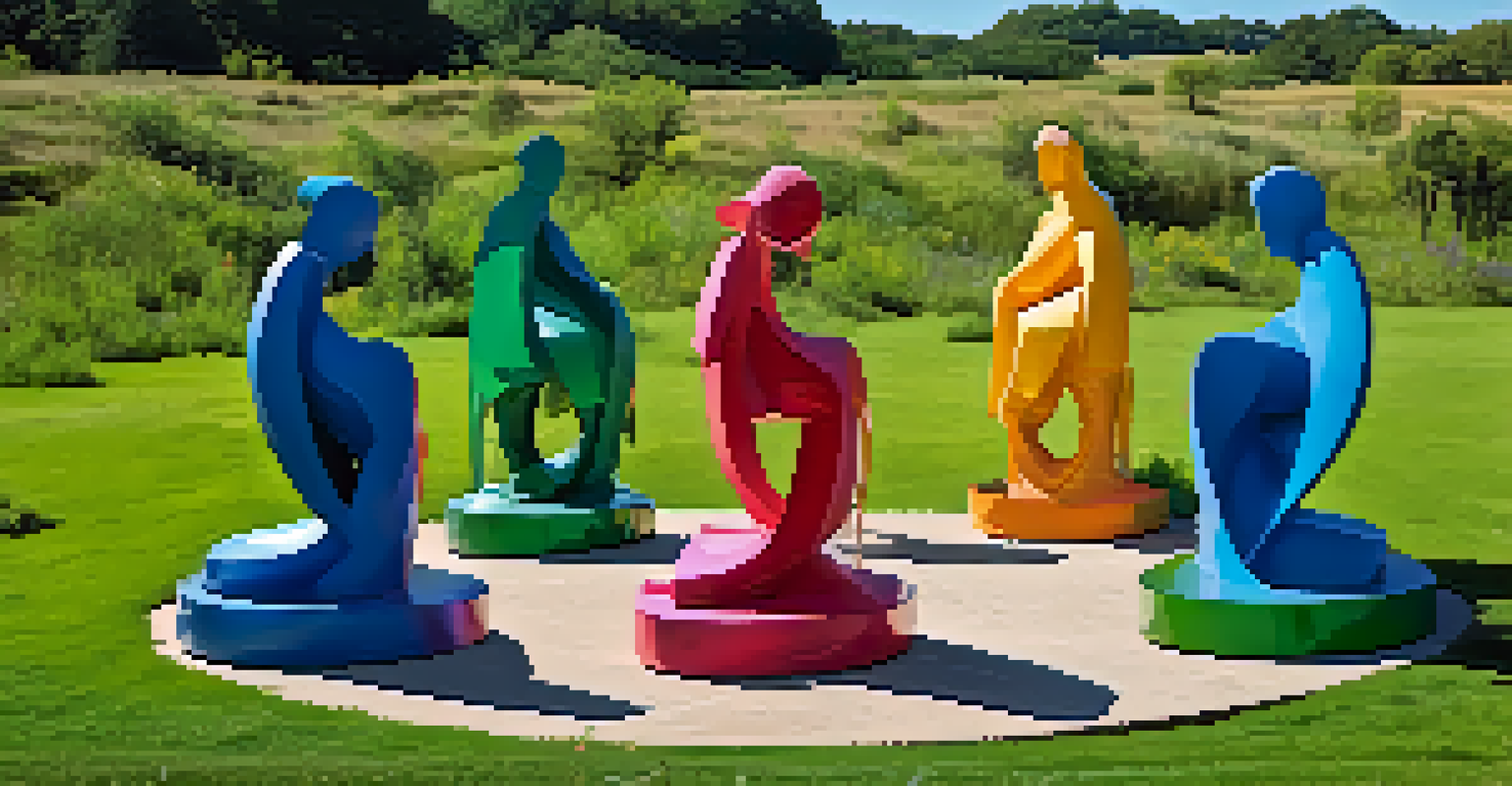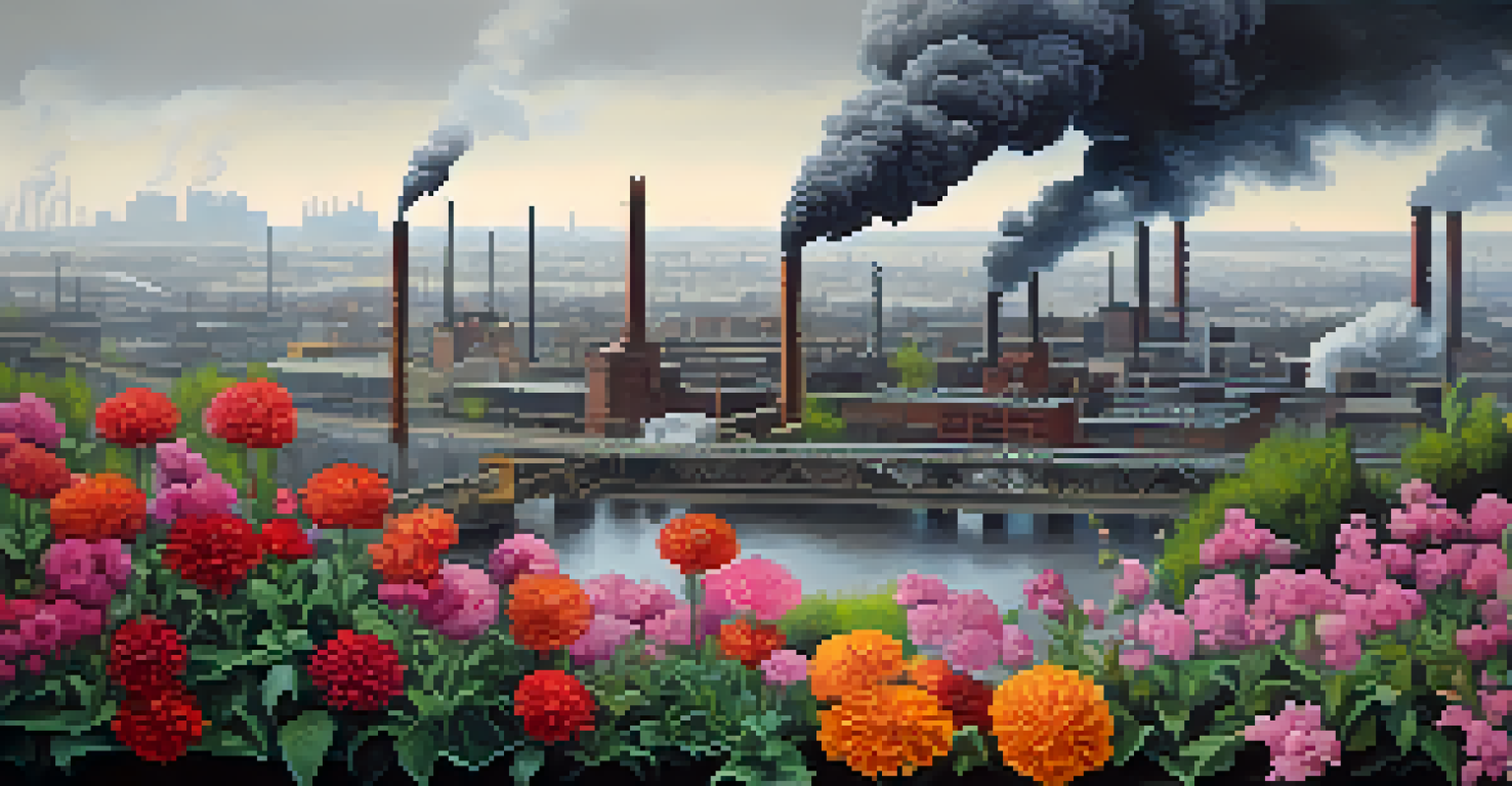Nature and Humanity: Art's Reflection on Environmental Issues

Art as a Mirror: Reflecting Environmental Concerns
Art has long served as a powerful mirror, reflecting societal values and issues. In today's context, it vividly captures the environmental challenges we face, from climate change to deforestation. These artistic expressions can provoke thought and inspire action, making the invisible struggles of nature visible to all.
Art is not a mirror held up to reality but a hammer with which to shape it.
Consider the striking images of melting glaciers in contemporary art; they evoke a visceral response that statistics alone may fail to achieve. Artists use their platforms to draw attention to ecological crises, allowing us to see the consequences of human actions on the planet. This connection can foster a greater appreciation for nature and a sense of urgency to protect it.
Ultimately, art’s role in reflecting environmental concerns lies in its ability to engage emotions and spark conversations. Through various mediums—be it painting, sculpture, or digital art—artists challenge us to confront the uncomfortable truths of our impact on the Earth.
Historical Perspectives: Art and Nature Through Time
Throughout history, art has celebrated the beauty of nature while simultaneously addressing its exploitation. From the romantic landscapes of the 19th century to the environmental installations of the modern era, artists have documented humanity's relationship with the natural world. These works often depict the tension between admiration for nature and the destructive forces of industrialization.

For example, the Hudson River School painters highlighted the American landscape's untouched beauty, igniting a sense of national pride. However, as industrialization ramped up, artists began to depict the changing landscapes and the environmental degradation that accompanied this progress. This shift illustrates how art evolves alongside societal values and issues.
Art Reflects Environmental Issues
Art serves as a powerful mirror to societal values, vividly capturing and provoking thought about the pressing environmental challenges we face today.
By reflecting on these historical perspectives, we can better understand our current environmental crisis. Art serves not only as a record of our past but also as a guide for navigating the future, reminding us of what is at stake.
Contemporary Artists Tackling Environmental Issues
Today, many contemporary artists are at the forefront of environmental activism, using their art to raise awareness and provoke change. Artists like Olafur Eliasson and Ai Weiwei create installations that highlight climate change and pollution, inviting viewers to engage with these critical issues. Their work often blurs the lines between art and activism, demonstrating the power of creativity to inspire action.
The earth does not belong to us. We belong to the earth.
For instance, Eliasson’s immersive installations challenge us to experience climate change firsthand, making the abstract concept of global warming tangible. Meanwhile, Ai Weiwei’s work often critiques political systems and their impact on environmental policies, showcasing the interconnectedness of human rights and ecological health. These artists exemplify how creativity can become a vehicle for social change.
As audiences increasingly seek meaning and purpose in art, these contemporary creators highlight the urgency of environmental issues. They remind us that art is not just a reflection of society but a tool for shaping it.
The Role of Art in Environmental Education
Art plays a crucial role in environmental education, making complex topics accessible and engaging. Through visual storytelling, artists can simplify intricate concepts like biodiversity loss or climate change, allowing individuals to grasp their significance. This approach fosters a deeper understanding and encourages proactive behaviors towards environmental stewardship.
Consider educational programs that incorporate art into their curriculum—students often resonate more with lessons that include visual elements. By harnessing creativity, educators can inspire a new generation of eco-conscious thinkers. Art can transform the way we perceive our relationship with the planet, fostering empathy and responsibility.
Artists as Environmental Activists
Contemporary artists like Olafur Eliasson and Ai Weiwei use their creative platforms to raise awareness and inspire action on critical environmental issues.
Moreover, community art projects can further enhance environmental awareness, bringing people together to collaborate on local issues. This collective creativity not only educates but also empowers individuals to take action, proving that art can indeed be a catalyst for change.
Art and Activism: A Powerful Partnership
The intersection of art and activism has proven to be a powerful force in raising awareness about environmental issues. Artists often collaborate with environmental organizations to amplify their messages, using their work to mobilize communities and influence policy. This partnership creates a dynamic platform for advocacy that resonates on multiple levels.
For instance, campaigns that feature striking visual art can capture public attention in ways traditional methods may not. When art is used to convey the urgency of a cause, it can inspire action and ignite passion within communities. This synergy between creativity and activism fosters a sense of collective responsibility towards the environment.
Artistic activism ultimately highlights the importance of community engagement in addressing environmental issues. By combining creativity with purpose, artists can inspire positive change and encourage individuals to become stewards of the planet.
The Emotional Impact of Environmental Art
One of the most compelling aspects of environmental art is its ability to evoke emotion. By tapping into our feelings, artists can create powerful connections between viewers and the natural world. This emotional resonance can be a motivating force, prompting individuals to reflect on their actions and their impact on the environment.
For example, a poignant photograph of a polluted landscape can elicit feelings of sadness and urgency, compelling viewers to advocate for change. Artists understand that emotions drive action, and by portraying the fragility of nature, they can inspire a sense of stewardship. This emotional connection is essential for fostering lasting change in how we interact with our environment.
Art's Role in Education and Change
By making complex environmental topics accessible, art plays a crucial role in education, fostering empathy and encouraging proactive behaviors towards stewardship.
Ultimately, the emotional impact of environmental art serves as a reminder of our shared responsibility to protect the Earth. By engaging our hearts as well as our minds, artists encourage us to take meaningful action in our own lives.
The Future of Art in Addressing Environmental Challenges
As we look to the future, the role of art in addressing environmental challenges will only become more critical. With increasing awareness of ecological issues, artists are poised to lead conversations about sustainability and conservation. They will continue to explore innovative ways to engage audiences and inspire action through their work.
Emerging technologies, such as virtual reality and immersive installations, offer new avenues for artists to convey their messages. These advancements can create powerful experiences that make the consequences of environmental neglect feel immediate and real. By harnessing these tools, artists can reach wider audiences and foster meaningful dialogue about the future of our planet.

In conclusion, the future of art in addressing environmental challenges lies in its ability to adapt and respond to societal needs. As artists continue to push boundaries, they will play an essential role in shaping our understanding of and relationship with the natural world.